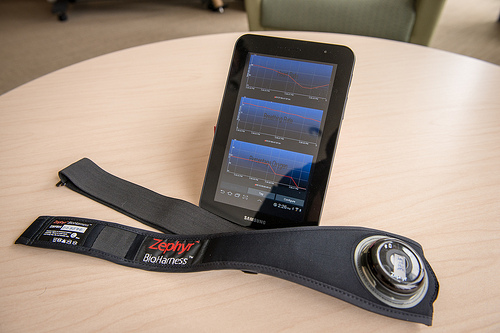UC San Diego Study Finds Beneficial Effects of Yoga on Heart Rate and Cellular Responses to Stress
By David Wang
San Diego, Calif., April 9, 2016 — A pilot study conducted at the University of California, San Diego Qualcomm Institute (QI) provides evidence that practicing yoga has beneficial effects on both resting heart rate and exercise heart rate. The study also suggests that regular yoga practice leads to decreased inflammation brought on by cellular stressors.

Linda Hill, a professor in the UC San Diego Department of Family Medicine and Public Health, led the Yoga as Exercise for Aerobic Health (YEAH) study, which was funded by a Calit2 Strategic Research Opportunities grant (Calit2 is the California Institute for Telecommunications and Information Technology, where QI is based). The purpose of the study was to quantify the effects of yoga -- in this case, a type of yoga that blends light aerobic activity with mindful breathing -- on systemic processes and specific cellular responses in the body, including inflammation.
Hill’s colleague on the study, David Wing, an Exercise Physiologist and Laboratory Director at the QI Exercise and Physical Activity Resource Center (EPARC), noted that traditional moderate to vigorous aerobic exercise stimulates the sympathetic nervous system (SNS), a division of the body’s autonomic nervous system that controls certain systemic processes in the body such as increasing heart rate (HR) and dilating airways -- processes that are also associated with the “fight or flight” response to a stressor.
The body’s recovery from stress, however -- even the stress brought on by exercise -- is largely controlled by the parasympathetic nervous system (PNS), the “rest and digest” function of the autonomic nervous system. PNS activation is largely responsible for decreasing HR during recovery from exercise.
Hill and her colleagues also theorized that improvements to the PNS would help to decrease the cellular response to chronic stressors (a taxing, deadline-driven job, for example) that can lead to harmful inflammatory responses linked to chronic diseases, including cancer. Therefore, Hill questioned if cellular resistance could be improved by engaging in an activity known for inducing a relaxation response: the “mindful movement, and breathing” of yoga.

For the study, sixteen ‘couch potatoes’ (those without consistent exercise for at least one year) participated in a bi-weekly yoga practice designed by UC San Diego cognitive neuroscientist Laura Schmalzl, which included movement patterns of Hatha flow yoga with the slow, controlled breathing emphasized in Ashtanga yoga. These previously sedentary individuals were monitored in real time for overall body condition measures, including breathing rate and HR variability, by way of the Zephyr Heart Rate monitor, which has been successfully combined with the “Bliss Buzzer,” a digital health app designed by Qualcomm Institute Director Ramesh Rao.
After three months of practice, improvements were observed in heart health, among those who practiced yoga, as evidenced by lower heart rate during an exercise step test and lower resting heart rates. The researchers attribute the improvement in heart health during exercise to a combination of the aerobically stimulating Hatha flow and the controlled breathing of Ashtanga-style yoga.
In previous studies, Hill’s research partners Andrew Baird and Brian Eliceiri, both in the UC San Diego Department of Surgery, have discovered that stimulation of the PNS in rodent models showed improved homeostasis (stability of internal conditions) in response to cellular stressors, and other studies in humans have showed improvement in heart rate variability, reduced blood pressure and reduced resting heart rate. Baird’s lab assisted Hill with assessments of health at the molecular level to determine if the yoga practice led to changes in cellular blood variables including stem cells, proteins and RNA, as well as decreased levels of C-reactive protein, which increases in response to inflammation.

The team concluded that the mindful movement of yoga leads to significant changes in cellular responses to stressors linked to inflammation. Explained Wing: “In a relatively short time of moderate frequency, a yoga practice appears to decrease sensitivity to inflammation on a cellular level.”
Wing also noted the study is the first to use this type of cellular-level analysis with physiological measurements of heart health in response to a yoga intervention.
An additional component of the study compared the inflammatory markers of the experimental group after three months of practice to that of a group of “experienced” yogis who have been regularly practicing Hatha and/or Ashtanga yoga for more than three years. The “experienced” group showed only slightly greater cellular resistance compared to the novice group measured at the end of the 3-month intervention.. This suggests, says Wing, the presence of a “dose response” for yoga asana in which the first “dose” of yoga has a large effect on the body’s cellular resistance to inflammation.
The team looks forward to expanding upon this pilot study in order to fully understand the practical usefulness of yoga asana in targeting pathways that affect human health.
Media Contacts
Tiffany Fox
(858) 246-0353
tfox@ucsd.edu

